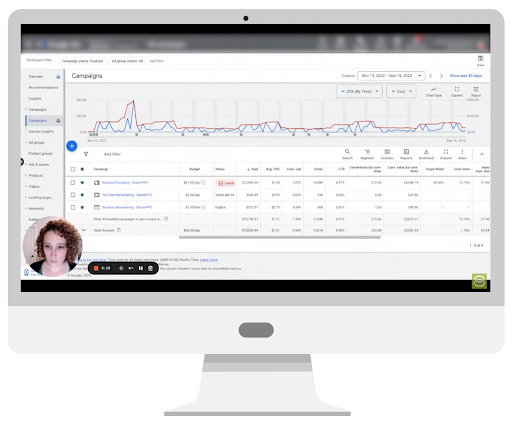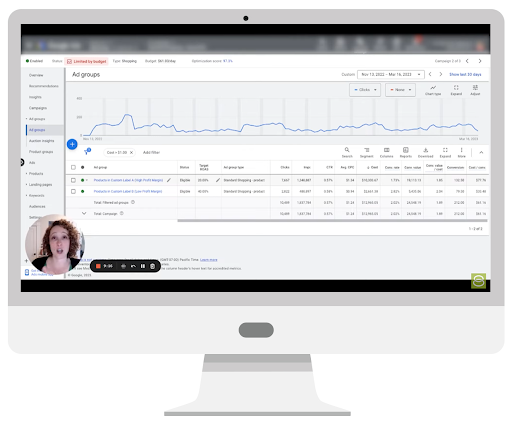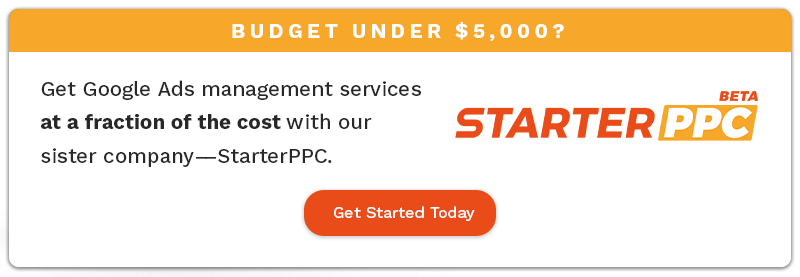Are you an eCommerce company with a lot of products but a small ad budget?
StarterPPC Executive Director Regina Bellows lays out a simple strategy in this video that can help you manipulate the Google Ads algorithm into focusing a higher amount of your Shopping campaign budget on the products of your choice.
As you may know, StarterPPC is our sister company, and they specialize in helping businesses with smaller budgets (under $5K monthly) find success with Google Ads. According to Regina, this strategy came about because she and her team had been working with a client with a lot of products but a limited budget.
So, let’s dive right in.
Table of Contents
When eCommerce businesses have hundreds or thousands of products, the Google Ads algorithm tends to home in on just a couple of those products.
And here is the reason: Once the algorithm sees that one or two products convert, it leans into those SKUs (regardless of whether or not they ever convert again) because it has become familiar with those products and seen that they were successful.
Basically, Google is not willing to experiment on its own, so it instead tries to optimize by finding something that it knows and learning all about that product—where to sell it, how to sell it, when to sell it, whom to sell it to, what placement to put it in, etc.—and then it tries to get you the best return for your dollar on that product.
But what if you think selling another product would be better?
Say your business has a bunch of products with a really high profit margin that you want to sell instead. Or maybe you have a ton of leftover inventory from last season that you really want to move. How do you get the algorithm to focus on those products?
When working with higher-budget campaigns, simply splitting the Shopping campaign into two or three or several different campaigns is a great way to get the algorithm to lean into specific products. However, when you are very budget restricted and your daily spend is barely enough to get a handful of clicks a day, this is not a viable option.
Essentially, when the algorithm doesn’t have enough daily spend to get a frequency of conversions in each campaign, it struggles. For example, it gets a conversion, waits a month, loses track of who’s been looking and who’s in the market, and the data that it got from that one conversion weeks ago is now old.
So, it becomes really difficult to build any momentum when you’re so budget restricted.
What should you do instead? Here's what Regina recommends.

In the video, Regina uses an example of an account for which they set up a Standard Shopping campaign. (Note: For this strategy, says Regina, you have to use Standard Shopping because Performance Max does not have the capability.)
Regina explains that they split the campaign down the middle into two Ad Groups—one with the highest profit margin products and one with the lowest profit margin products. You can do this by adding a custom label in the feed (e.g., custom label A, custom label B), and what it allows you to do is manipulate the bidding strategy separately on one category versus the other in order to try to focus the algorithm in one direction.
She points out that in this case, the high profit margin products have a target ROAS of only 20%, while the low profit margin products have a target ROAS of 40%.
Setting a low target ROAS is a smart move.
Keep in mind, says Regina, that it doesn’t really matter what these numbers are, although she and her team have found that setting a low target ROAS in Standard Shopping can be really beneficial—because setting it too high can be too restrictive, and the algorithm gives up and stops spending after a few days when it’s not hitting that goal.
So, for this strategy, she recommends setting a low target ROAS—one that is less restrictive in the high profit margin products Ad Group because we want the algorithm to be free to spend more in there.
Now, you might think the second you start spend more money in the Ad Group with the more expensive products, that you’ll get a lower return. And yes, this is true temporarily, since any time you shift the algorithm to focus on something new, the ROAS will go down. But the point of this strategy is to manipulate the algorithm’s focus and get it to familiarize itself with your favorite products over the long term.
However, Regina doesn’t recommend doing this in an extreme way.

Start small and focus on the long game.
Instead, she says to start small, for example by switching the 20% and 40% in the example campaign both to 30%, and then slowly lowering by 5% each week until you get it where you want it to be. By slowly manipulating the bids over time, it will result in more and more budget being spent on the high profit margin products.
“We’re not making a hard cut and saying, ‘Hey algorithm, you can’t spend money on the low margin products’, right? Because that’s restrictive,” explains Regina. “That takes the budget and splits it in half. Instead, what we’re doing is we’re saying you can do whatever you want, but you need to get us double the return over here if you’re gonna spend money.”
And sure enough, the strategy has worked.
Bottom line: Don’t let the ROAS sway you, says Regina. If you want to sell a specific group of products because you know it will be better for your bottom line, do it. This strategy has worked for us, and we hope it works for you!
Just remember: This is a long-term strategy, and it’s all about creating a healthy algorithm over time with bids rather than pushing budget into one group of products over another.
Google Ads on a limited budget? StarterPPC has you covered.
StarterPPC provides Google Ads Management services to small business owners at a fraction of the cost of most agencies. You still get all of the Solutions 8 services and expertise; we just removed some of the major expenses associated with client management (read: meetings) to reduce charges to a bare minimum.
Author
Pamela is the Senior Content Writer at Solutions 8. When she's not writing, you can find her hiking in the woods with her dogs. She is currently on a quest to visit every national park in the United States.
 Pamela Sapio
Pamela Sapio












